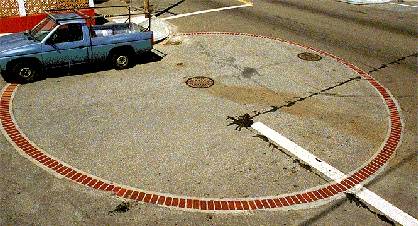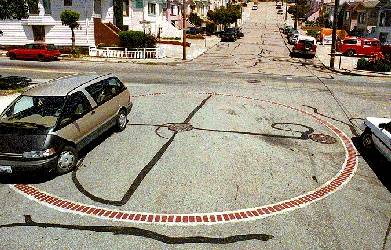CISTERNS: Difference between revisions
m (1 revision(s)) |
Texteradmin (talk | contribs) No edit summary |
||
| (8 intermediate revisions by 3 users not shown) | |||
| Line 1: | Line 1: | ||
'''<font face = Papyrus> <font color = maroon> <font size = 4>Historical Essay</font></font> </font>''' | |||
''by Joe Caffentzis'' | |||
[[Image:ecology1$cistern-1.jpg]] | |||
'''One of the cisterns that were built after the early fires in San Francisco.''' | |||
''Photo: Chris Carlsson'' | |||
As you wander around San Francisco, notice the occasional circle of red bricks or cobblestones in various intersections. San Francisco, with its many wood-frame homes has always been vulnerable to fire. There were the First Great [[FIRE!| Fire]] (1849) and the Second Great Fire (May 1850). After the Third Great Fire (June 18, 1850), the city fathers funded the construction of cisterns to assure a water supply for fire-fighting equipment. | |||
[[Image:ecology1$cistern-2.jpg]] | [[Image:ecology1$cistern-2.jpg]] | ||
One of many cisterns built to hold water for fire-fighting in the event of failures in the main water distribution system. | '''One of many cisterns built to hold water for fire-fighting in the event of failures in the main water distribution system.''' | ||
''Photo: Chris Carlsson'' | |||
The Haight has its share of later additions to the system. The stones you see in the roadbed cap a huge cistern which sits just below street level. There are approximately 150 throughout the city and they are maintained today in order to provide water in case an earthquake should cut water lines. The city's cisterns are always heralded by green-bonneted hydrants. Also note the red-bonneted hydrants, which are outlets for the high pressure fire-fighting water line. | |||
<hr> | |||
[[Image:Tours-water.gif|link= Sewerage]] [[Sewerage| Continue Water Tour]] | |||
[[San Francisco's Clean Little Secret | Prev. Document]] [[Who Pays for Public Water? S.F. vs. Suburbs | Next Document]] | |||
[[ | [[category:Ecology]] [[category:1990s]] [[category:Haight-Ashbury]] [[category:water]] [[category:1850s]] | ||
Latest revision as of 18:53, 20 August 2009
Historical Essay
by Joe Caffentzis
One of the cisterns that were built after the early fires in San Francisco.
Photo: Chris Carlsson
As you wander around San Francisco, notice the occasional circle of red bricks or cobblestones in various intersections. San Francisco, with its many wood-frame homes has always been vulnerable to fire. There were the First Great Fire (1849) and the Second Great Fire (May 1850). After the Third Great Fire (June 18, 1850), the city fathers funded the construction of cisterns to assure a water supply for fire-fighting equipment.
One of many cisterns built to hold water for fire-fighting in the event of failures in the main water distribution system.
Photo: Chris Carlsson
The Haight has its share of later additions to the system. The stones you see in the roadbed cap a huge cistern which sits just below street level. There are approximately 150 throughout the city and they are maintained today in order to provide water in case an earthquake should cut water lines. The city's cisterns are always heralded by green-bonneted hydrants. Also note the red-bonneted hydrants, which are outlets for the high pressure fire-fighting water line.


